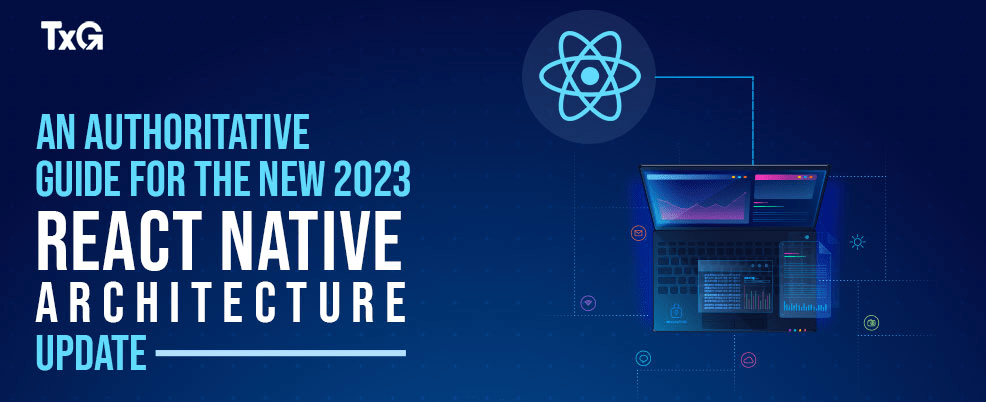React Native, a popular framework for building cross-platform mobile applications has recently undergone significant architectural updates in 2023. These updates bring new features, improved performance, and enhanced developer experience. In this comprehensive guide, we will explore the key changes introduced in the latest React Native architecture update and provide an authoritative overview of their impact on app development.
What features will be available in the new React Native Architecture update in 2023?
The new 2023 React Native Architecture Update introduces several exciting features and improvements that enhance the performance, developer experience and overall capabilities of the framework. Here are some key features of the update:
- Enhanced Performance:
The update focuses on optimizing performance and app responsiveness. It introduces a new threading model that allows for concurrent execution, resulting in faster rendering and improved UI responsiveness. Additionally, improvements in the JavaScript runtime enhance the efficiency of JavaScript code execution, leading to better overall performance.
- Component-Level Updates:
The updated architecture introduces a more modular approach to building applications. It leverages the concept of “Fabric” to enable component-level updates. This means that when a change is made to a specific component, only that component and its dependencies are re-rendered, minimizing unnecessary re-renders and improving overall efficiency.
- Improved Memory Management:
The new architecture includes enhancements in memory management, reducing the memory footprint of React Native applications. This leads to improved memory efficiency and better overall app performance, particularly on devices with limited resources.
- Hot Reloading:
The update improves the hot reloading functionality, allowing developers to instantly see changes made to the code without restarting the entire application. This feature significantly speeds up the development process, enabling developers to iterate quickly and see the impact of their changes in real time.
- Better Developer Tooling:
The new architecture introduces enhancements to the developer tooling, including improvements in debugging capabilities. Developers gain access to more powerful debugging tools that help identify and fix issues more efficiently. These tools provide better insights into application behavior and facilitate faster troubleshooting.
- Support for Concurrent Mode:
The updated architecture lays the groundwork for Concurrent Mode, a new feature in React that allows for asynchronous rendering and better handling of large and complex applications. Although Concurrent Mode is not fully available in the 2023 update, the new architecture sets the stage for its future integration.
- Improved Bridge Communication:
The bridge communication between JavaScript and native code has been optimized in the new architecture, resulting in faster and more efficient data transfer. This leads to improved overall performance and reduced latency in communication between the React Native runtime and native modules.
- Enhanced Developer Experience:
The update aims to enhance the overall developer experience by providing better tooling, improved documentation, and more streamlined workflows. Developers can benefit from a smoother development process, faster iterations, and easier debugging and profiling of their applications.
These features and improvements in the new 2023 React Native Architecture Update empower developers to create high-performing, scalable, and efficient cross-platform mobile applications while providing a better development experience.
To migrate to the new update of React Native Architecture, follow these steps:
- Understand the Changes: Study the documentation and release notes to familiarize yourself with the key changes and improvements.
- Assess Compatibility: Evaluate your project for compatibility, identifying any dependencies or custom modules that may need updates.
- Create a Migration Plan: Develop a detailed plan with steps, timeline, and resources needed for the transition.
- Update Dependencies: Update React Native and ensure compatibility with libraries and packages used in your project.
- Test and Validate: Set up a robust testing strategy to verify functionality and performance after the migration.
- Address Breaking Changes: Modify codebase, refactor components, and update deprecated methods or APIs affected by breaking changes.
- Iterate and Optimize: Optimize performance, leverage new features, and improve overall code quality.
- Documentation and Support: Update project documentation, document workarounds, and seek support from the React Native community.
By following these steps, you can successfully migrate to the new React Native architecture update while ensuring a smooth transition and improved development experience.
Remember, it’s essential to thoroughly test your application at each stage of the migration process and have a rollback plan in case any critical issues arise. Migrating to the new 2023 React Native Architecture may require time and effort, but it provides an opportunity to leverage improved performance, scalability, and developer experience in your mobile application development.
Conclusion
In conclusion, the new 2023 React Architecture Update brings exciting features and improvements that enhance performance, developer experience, and overall capabilities of the framework. With enhancements such as enhanced performance, component-level updates, improved memory management, hot reloading, better developer tooling, support for concurrent mode, optimized bridge communication, and an enhanced developer experience, developers can create high-performing, scalable, and efficient cross-platform mobile applications.
How can Tecnolynx help you?
Our team of experienced React Native developers is well-versed in the latest architecture update. We have a deep understanding of the changes, improvements, and best practices associated with the new update. We can provide guidance and implement the necessary changes in your existing codebase to ensure a seamless migration.
We can assess your current React Native project for compatibility with the new architecture. Our team will identify any dependencies or custom modules that need to be updated or replaced. We’ll also evaluate the impact on third-party integrations and provide recommendations to ensure smooth compatibility during the migration process.
We will create a detailed migration plan tailored to your business requirements. Our experts will handle the migration process, taking care of tasks such as updating dependencies, addressing breaking changes, and optimizing performance. With our expertise, we aim to minimize disruptions and ensure a smooth transition to the new React Native architecture.
Our services extend beyond the migration process. As a React Native development company, we offer ongoing support and maintenance to businesses. We provide assistance with debugging, performance optimization, feature enhancements, and updates to keep your application running smoothly with the latest architecture.
By leveraging our expertise, businesses can confidently embrace the new React Native architecture update, ensuring a seamless migration process and continued support for their React Native applications.


